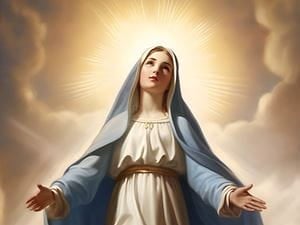
In Luke 1:28, God described Mary, the mother of Jesus, as “highly favored.” The phrase comes from a Greek word that means “much grace,” for Mary received God’s grace. Grace is an unmerited favor or a blessing we receive despite the fact that we don’t deserve it. Mary needed grace from God and a Savior like the rest of us. Luke 1:47 confirms that she understood this fact.
The Bible is over 95 percent male-oriented. However, Mary of Nazareth is among the women most mentioned in the Bible, that is, in the New Testament. She’s an exception to the rule and, for that reason, an exceptional woman.
What religion was Mary before she had Jesus?
The information we gain from the Bible on Mary’s life is by no means abundant. As far as the details about Mary’s person are concerned, we don’t know much about her knowledge or liking. However, through God’s spiritual intervention in her life, she becomes a person in terms of her religious vocation. Her process of individuality is commenced by her reflection on who she is and her mission as a handmaid of the Lord. It’s not possible to establish an exact chronological point for identifying Mary’s birth date.
Mary of Nazareth, the daughter of Anna and Joachim, is first mentioned by name in the Gospel of Matthew. She’s a regular woman, and her name was common enough that other women with the same name in the gospel had to be distinguished by their place of origin or relatives. From tradition, we can assume that Mary grew up as a young Jewish girl in the small town of Galilee. Being born into Judaism, she experienced the Hebrew Scriptures in her prayer and her life as a woman of Nazareth.
Her education as a girl included listening to Torah readings and the prophets in the synagogue. We can’t know for sure, but it’s possible that Mary knew how to read. Like all Jewish girls, Mary would have been submissive, docile, and obedient to her parents’ wishes. Thus, when she was of marriageable age, which was about 14, her parents promised her to marry a man years her senior, and she accepted their decision. In reality, she had no choice. We can also assume that it was around that time that Mary was betrothed to Joseph.
During this betrothal period, the angel Gabriel visited Mary and told her of her approaching pregnancy. It’s no wonder that she was so curious about the angel. Mary was a virgin and would know no man sexually for months, maybe as long as a year or more. Joseph soon became aware of Mary’s pregnancy, which was a cause for alarm on his behalf. However, Matthew 1:19 tells us that Joseph was a righteous man and didn’t want to expose Mary to public disgrace, so he considered divorcing her quietly. Although the marriage hadn’t been consummated, Jewish custom allowed them to be considered husband and wife.
Mary and Joseph hadn’t experienced sexual contact with each other, so Joseph was in a dilemma. Jewish law provided that his betrothal, due to her unfaithfulness, could be positioned before the elders for judgment and stoned to death. However, Joseph wanted to simply put Mary away quietly without public knowledge. In ancient times, marriage engagements or betrothals were binding and could only be dismissed by an official divorce decree.
Then, Matthew 1:20-25 says that an angel came to Joseph in a dream and explained to him that Mary’s pregnancy was bringing the fulfillment of a prophecy that a virgin would bear a child who would be the Savior. So, Joseph did what the angel of the Lord told him and took Mary as his wife. However, he had no union with her until she gave birth to a son, giving him the name Jesus.
What happened after Jesus’ birth?
After Jesus was born, Joseph and Mary brought Jesus to the temple to show Him to the Lord and offer an appropriate sacrifice, as they were commanded to do under Jewish law. The couple met two prophets who immediately recognized Jesus as the Promised One of Israel. Anna, an aged woman, blessed the Child, and Simon prophesied over Him, giving Mary a hint of the sorry that would pierce her heart one day when her Son would suffer for the world’s sins.
Luke 2:41-52 is the next time we see Mary. Jesus was 12 years old and attending Passover at the temple for the first time, which was the Jewish custom. Becoming aware of His true identity, Jesus spent His time in the temple with the teachers and priests, shocking them with His wisdom. Joseph and Mary started their trek home without them, thinking He was with the others in their caravan. They traveled for a day before realizing He wasn’t with them. They got back to Jerusalem and spent three days looking for Him.
Mary expressed a typical mother’s frustration when they found Him, scolding Him for scaring them that way. The next time we hear about Mary is at the beginning of Jesus’ three-year ministry. John 2:1-10 tells us that Jesus was invited to a wedding in Cana, and they ran out of wine, and Mary told Jesus about it. Then, Jesus quietly performed His first miracle, turning 150 gallons of water into fine wine. After the wedding, Jesus went with His mother, brothers, and disciples to Capernaum and stayed for a few days. The fact that the verse only mentions Mary, not Joseph, indicates that he had died at some point during Jesus’ growing years.
Despite the astonishing events surrounding His birth, Mary still didn’t fully grasp her firstborn Son’s genuine purpose. Matthew 12:46-48 recounts an incident when Mary and Jesus’ brothers beckoned Him as He was preaching. His response indicated that He understood that those closest to Him didn’t yet understand or believe Him as Israel’s Messiah. In John 7:2-5, Jesus’ brothers tried to dissuade Him from what God sent Him to do, which also indicates that Mary continued to be puzzled about His role in coming to earth.
Mary, the mother of Jesus Christ, is one of the most famous women ever. Her name is easily recognized, but we actually know little about her upbringing or her life after Jesus’ crucifixion. However, we do know that she grew up as a Jewish girl who obeyed her parents and the calling on her life.

